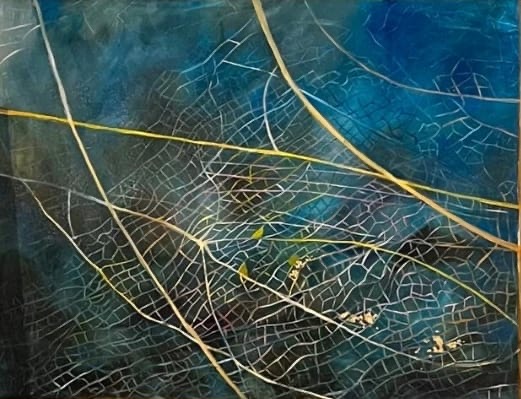Fifteen years ago, Puneeta Ranjan left a stable finance career behind and picked up a paintbrush full-time. Since then, she’s been creating art in Pune—quietly, steadily, with purpose. Her work has traveled to galleries across India and abroad, filled corporate spaces, and colored city streets. But it’s not just about exhibitions or commissions for her. Art, for Ranjan, is a tool. A way to reflect, to beautify, to teach, to connect.

She’s run interactive workshops, taken on public art projects, and worked with underprivileged children. Her drive is simple: bring art into everyday life. Not just to look at, but to live with. To use. To start conversations. Whether it’s a wall in a neglected part of the city or a classroom full of curious kids, Ranjan steps in with color, ideas, and an open hand.
Her latest work, a tetraptych titled We Are All Connected, digs into that same idea of connection. It’s a set of four oil-on-canvas pieces, each 36 by 48 inches. Put together, they form a layered, shifting pattern. At first glance, you might see a map, or the delicate network of veins in a leaf. Step back and maybe it becomes a butterfly wing, or a city grid seen from above. Each part echoes the others. Each part could be a whole on its own.
That’s no accident. The work is built on fractal geometry—the repeating patterns found everywhere in nature—and the Buddhist idea of Indra’s Net, where every point reflects all the others, endlessly. The deeper you look, the more it opens up. You start seeing patterns that weren’t there a moment ago. Or maybe they were, and you just weren’t ready to see them yet.
Ranjan doesn’t tell you what to find in the work. She invites you to see what you see. That kind of openness runs through everything she does. Her 2024 solo show, The Poetry of Gaia, which featured this series, was more than a display of paintings. It was a meditation on nature, rhythm, and our place in the bigger picture. Gaia, the living earth, isn’t just a theme for Ranjan—it’s something she believes in. Something she paints with respect.
Her canvas is never just a surface. It’s a meeting point. Of science and spirit, precision and freedom. She loves structure—grids, patterns, systems—but she lets them breathe. Her lattice paintings show “regular irregularity,” a balance between the expected and the organic. Nothing is completely symmetrical. Nothing is out of place. It’s a visual metaphor for how the world actually works.
She brings that same sense of balance to her life outside the studio. Ranjan has taken art to the streets—literally—working on beautification projects to turn drab public spaces into places people want to look at, linger in, maybe even take care of. She believes cities should be beautiful, not just functional. She sees value in color, even in unlikely places.
When she works with children, especially those without access to formal art education, she doesn’t just teach them how to draw. She shows them how to see. How to think differently. How to use art to express what they might not be able to say out loud. That kind of work doesn’t always make headlines, but it plants something real.
Ranjan isn’t chasing trends or labels. She’s building something slower. More rooted. Her art pulls from mathematics, spirituality, ecology—all woven together with oil paint and instinct. There’s no sharp boundary between her artwork and her worldview. For her, they’re the same thing.
She’s still based in Pune, still painting, still showing up for her city and her people. There’s a quiet clarity in the way she speaks about her work. No jargon. No overreach. Just the truth of what she sees and what she hopes others might see too: that we’re all part of the same web. People, trees, animals, rivers. Cities and cells. All stitched together, whether we notice or not.
And that’s the point of her work—not to shout, but to reveal. To remind us that beauty, connection, and complexity aren’t things we have to go looking for. They’re already here. We just need to look.

